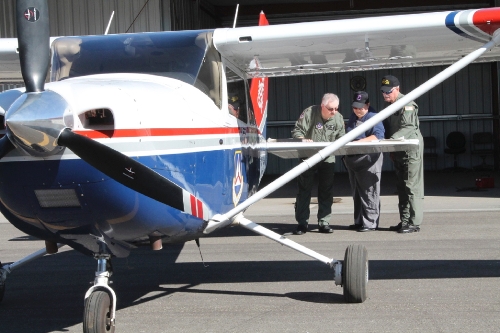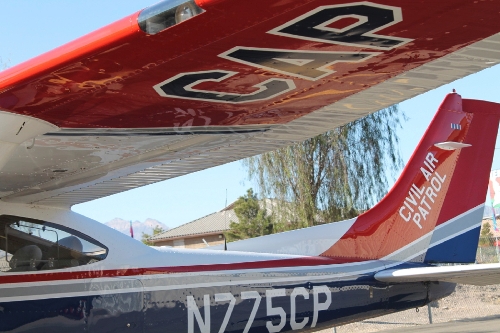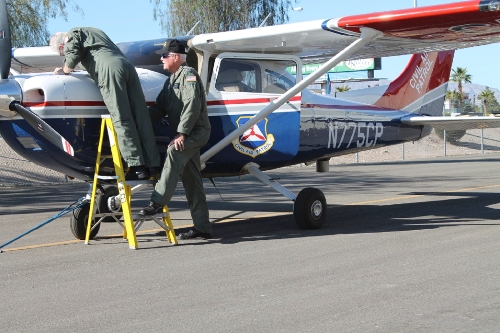Civil Air Patrol volunteers give Air Force a hand on humanitarian missions
The weathered, beige paint and threadbare porch furniture give the early-century ranch house a well-used appearance, yet it is locked and quiet, shades drawn over the dark windows.
A stack of colorful aerospace textbooks, still tightly wrapped in plastic, sits behind a half-open screen door. A towering radio antenna spikes skyward from the ground a few feet away. The jumble of chairs on the patio awaits a sizable gathering. This house serves a much greater purpose than it would seem at first glance.
Behind it, in a long aluminum-sided hangar surrounded by a barbed wire fence, a massive metal door retracts. A gleaming aircraft with bold red, white and blue markings glides on its wheels as it is tugged out of the hangar and onto the tarmac.
Three uniformed figures guide the craft carefully out of its protective structure. Two wear green flight suits, the third wears gray and blue attire; all wear dark aviator sunglasses. Their inspection of the Cessna is organized and procedural, though they trade jokes in the relaxed manner of a crew intimately comfortable with its vehicle.
What makes the members of this aircrew different than other private or commercial Cessna crews is that they collaborate with the Air Force on humanitarian missions. These fliers are civilians who serve in the Civil Air Patrol (CAP).
CAP aircrews consist of volunteers from all backgrounds, including military, civilian, health care, education, media, law and technical trades. Some volunteers fly missions. Others provide ground crew and support services from the ranch house that is their headquarters and mission base. What they all share is a desire to use aviation to help people in need.
"It's a blast to fly with Civil Air Patrol," said Maj. Tom Cooper, a Henderson resident and mission observer and public affairs officer with Nevada Wing Civil Air Patrol. "It's the best feeling to fly over the beautiful Nevada wilderness and help the community at the same time."
Cooper joined CAP 10 years ago when he moved to Las Vegas and found no volunteer ambulance service to which he could donate his flight nurse skills.
"I'd always had an interest in flying and heard that anyone can volunteer with CAP and learn to fly through their training programs," said Cooper, who is studying to be a pilot through CAP. He fills two roles in CAP now: mission observer, which is a mission commander and radio communications person on the flights; and public affairs officer, who shares information about CAP with the media and the public.
"I've learned all those skills through CAP, as any volunteer can," he said.
Cooper has been involved in several high-profile missions during his service to the Nevada Wing CAP. The month long aerial search for aviator Stephen Fossett in 2007 was exhausting and frustrating for the Nevada Wing crews.
"We all devoted whatever time we could away from our jobs to comb each ridge and valley hoping to spot some sign of him," Cooper recalled. "We slept very little between flying and working, and this was physically demanding for most everyone."
Failing to find Fossett before the search was called off was a disappointment that weighed heavily on each member.
"We have to console ourselves with the thought that we did our best," Cooper said, shaking his head slowly.
He noted that other missions are more straightforward. In 2002, the Western Arizona Regional Medical Center in Bullhead City ran out of blood supply after motorcycle gang shootings; Nevada Wing CAP airlifted blood supply materials to the hospital so it could resume giving transfusions to patients.
"We just finished our annual aerial survey for Nellis, helping them update their flight maps," Cooper said. CAP aircrews fly around the borders of the Nellis Air Force Base testing area, mapping newly built tall structures, such as cell towers. Air Force test pilots incorporate this information into flight plans to avoid collisions with the structures.
That aerial survey can be a grueling process for the aircrews.
"We have multiple crews up in Cessna aircraft, flying in parallel formation for many hours at a time," he said. "The photographers are in the cramped back seats, snapping pictures out the side and rear windows. The cabin heaters are not very efficient, and there's no air conditioning, so climate control is nonexistent."
But flying and serving the community are overriding passions for the unpaid CAP members, and temporary discomforts are far outweighed by the thrill of aerial missions.
CAP historically has provided a variety of services to the military and civilian communities. CAP grew out of the Coastal Patrol, a volunteer aerial unit that formed one week before Pearl Harbor was attacked in 1941.
"Pilots who were not in the military wanted to contribute to the war effort, so they flew their own personal planes on combat missions against German U-boats that were attacking American supply ships," said Capt. William Peterson, a Paradise resident and a pilot in Nevada Wing CAP. The Coastal Patrol pilots relentlessly harassed, bombed and even sank enemy submarines along the eastern U.S. seaboard, playing a pivotal role in ending the German invasion of American waters.
The new airborne unit, consisting entirely of volunteer civilians, also transported supplies, searched for lost planes and pilots and carried out aerial reconnaissance, duties that remain to this day. Following disasters, such as 9/11 and Hurricane Katrina, CAP crews are the first to provide the military and the government with aerial photographs of the areas affected.
Today's CAP, an auxiliary unit of the Air Force, also provides training for volunteers as young as 12 years old.
"We have a strong cadet program for teens," said Capt. Althea Levell, a North Las Vegas resident and a scanner, flight photographer and cadet instructor in the Nevada Wing CAP. Cadets learn aerospace theory, military basics and formations, ground search techniques, and they fly in the aircraft as passengers.
"You can see the confidence and leadership skills improve so much as the cadets progress through the program," said Levell, who also is a substance abuse counseling intern.
CAP cadet programs frequently feed graduates into the Air Force.
"Of course, Nevada's most famous cadet graduate is Maj. Nicole Malachowski, the first woman to serve as a Thunderbird pilot," Cooper said. "The cadets really look up to her."
For now, the shuttered house by the airport sits quietly. But the next time the Air Force calls, it stands ready to serve as the meeting place for the multi-generation volunteers of an organization that was truly battle-born.
























